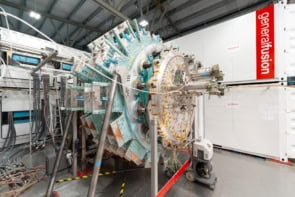Physicists in the US have put forward a new way of measuring one of the most important but elusive quantities in particle physics — the mass of the neutrino. The proposed experiment borrows techniques from atomic physics to lower the temperature of tritium atoms to nearly absolute zero and then study their beta decay.
A more precise measurement of neutrino mass is important because it will tell physicists what sort of theory is needed to extend the Standard Model of particle physics. A better value could also help astrophysicists work out how much of the universe’s dark matter can be accounted for by neutrinos.
The Standard Model itself assumes that neutrinos have zero mass. However several different experiments have proven that neutrinos oscillate between three different types or “flavours” — which can only happen if neutrinos have mass. Unfortunately, oscillation measurements are only sensitive to differences between the squares of the masses of different flavours, not absolute mass.
Physicists do know that the neutrino mass is less than 2.2 eV because of two independent experiments involving beta-decay — whereby a neutron in a tritium nucleus turns into a proton, emitting an electron and an antineutrino. Careful measurements of the energies of a large number of such electrons gives an upper limit on neutrino mass. A larger version of these experiments called KATRIN switches on in Germany in 2012 and should be able to further constrain the neutrino mass to 0.2 eV.
Nature does not easily reveal the secrets of the neutrino mass Guido Drexlin, KATRIN project
Other experiments, meanwhile, will measure neutrino mass by studying a very rare form of beta decay in which two neutrons inside a nucleus transform into protons at the same time, emitting two electrons but no neutrinos. The half-life of this process depends on the value of neutrino mass. Neutrino mass can also be deduced from measurements of the cosmic microwave background — the current upper limit is 1 eV — but this result depends on certain assumptions about the evolution of the universe.
Measuring motions of various particles
Now, a team including Mark Raizen at the University of Texas at Austin and Joshua Klein at the University of Pennsylvania has proposed a new way of making extremely precise measurements of the motions of the various particles involved in the beta decay of tritium.
To ensure that the system is initially as close to absolute standstill as possible, this proposal involves cooling a gas of tritium atoms to within a few millionths of a degree of absolute zero. Raizen’s group is currently working out how to cool tritium and other hydrogen isotopes by slowing down beams of these atoms using magnets and then gradually transferring their remaining momentum to individual photons. They then propose two alternative ways of measuring the neutrino mass (arXiv:0901.3111).
The first of these involves studying what is known as the “boundstate” beta decay of tritium. In this process, which has not yet been observed, the emitted electron becomes bound into the helium atom rather than escaping. This makes the decay a straightforward two-body process, in which the energy of the emitted neutrino is equal to the energy difference between the initial tritium atom and the daughter helium atom. The neutrino mass can be calculated simply by measuring the velocity of the nuclear recoil, which can in principle be done by detecting the time it takes for the helium atom to arrive at a detector placed some known distance from the tritium source.
The second method studies the three-body beta decay of tritium and involves using various detectors to work out the momenta of the daughter helium ion and the emitted electron. The neutrino mass is then calculated directly from these quantities.
Maximizing the number of decays
Both of these techniques rely on maximizing the number of decays in order to achieve as high a sensitivity as possible. Raizen and co-workers have worked out that by trapping some 1013 tritium atoms — the maximum that can feasibly be attained over the course of about a year — they would reach a somewhat disappointing upper limit on the neutrino mass of around 9 eV with the first approach, but could get down to roughly the limit possible with KATRIN — 0.2 eV — with the second.
These figures, however, were generated using a computer simulation. Whether the 0.2 eV limit could be reproduced in an actual experiment — which the researchers hope to carry out within the next decade — depends on overcoming several significant engineering challenges, not least of which is finding out how many atoms can in fact be trapped.
KATRIN project leader Guido Drexlin says that the approach of Raizen’s team is, in principle, very interesting. But he emphasizes that much work must be done to put the idea into practice. “Nature does not easily reveal the secrets of the neutrino mass,” he adds. “The name of the game in direct neutrino mass sensitivity is always the same: statistics, statistics, statistics, and carefully control all your systematics.”



